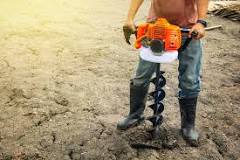Digging a 4-foot hole is a common task that can be required for a variety of projects, such as installing fence posts, planting trees, or building retaining walls. Digging a hole might seem like a straightforward task, but determining how long it takes to dig a 4-foot hole can be more complex than it appears.
Factors such as soil type, digging methods, and the digger’s experience all contribute to the time it takes to complete the job. In this blog post, we will explore these factors and provide some helpful tips to make your hole-digging project a success.

Soil Type: A Major Determinant of Digging Speed
The time it takes to dig a 4-foot hole can vary greatly depending on the type of soil you’re working with. Here are some common soil types and their impact on digging speed:
Loose soil
This type of soil is relatively easy to dig through, as it offers little resistance. Examples include sandy or loamy soils. Digging through loose soil can be quite fast, taking just a few minutes per foot with a standard shovel.
Clay soil
Clay soils are more challenging to dig through, as they tend to be dense and sticky. This type of soil can slow down your digging speed significantly, potentially taking up to an hour or more per foot.
Rocky soil
As you might expect, rocky soil is the most difficult to dig through. The presence of rocks and other hard materials can make it nearly impossible to use a shovel effectively. In these cases, you may need to use specialized tools or machinery to complete the job, which can add hours or even days to the project.
Digging Methods: Manual vs. Mechanical
The method you choose to dig your 4-foot hole will also have a significant impact on the time it takes to complete the project.
Manual digging
Using a shovel or pickaxe is the most common method for small-scale digging projects. This method can be time-consuming, especially for inexperienced diggers or in challenging soil conditions. On average, a reasonably fit person can dig about 1 to 2 cubic feet of soil per hour, depending on the soil type.
Mechanical digging
For larger or more complex projects, mechanical digging methods such as using a backhoe or excavator can save a significant amount of time. These machines can dig a 4-foot hole in minutes, but they also require more planning, higher costs, and potentially skilled operators.
What Is the Fastest Way to Dig a Hole in a Shovel?
Choosing the Right Tools and Equipment for Digging a 4-Foot Hole
Digging a 4-foot hole can be a daunting task, especially if you don’t have the right tools and equipment. Depending on the job and the soil conditions, there are several options available for users looking to dig a 4-foot hole quickly and efficiently.

One popular tool for digging holes is the post hole digger. A post hole digger is a manual tool with two metal blades that are used to dig holes in the ground. The blades are shaped like semi-circles, and they are designed to scoop out soil as you dig. Post hole diggers come in various sizes, but for a 4-foot hole, a 6-inch post hole digger would be sufficient. Using a post hole digger can be hard work, but it is an effective way to dig a hole if you have the physical ability to do so.

Another option is an auger, which is a power tool used for digging holes. Augers come in various sizes, and they are particularly useful for digging holes in hard soil or rocky ground. A gas-powered auger is the most powerful option and can be rented from many hardware stores. If you plan on digging more than one hole, renting an auger may be a cost-effective option.
It’s worth noting that using an auger requires some skill and knowledge, so it’s important to follow all safety instructions and take precautions to avoid accidents.
On average, using a post hole digger can take between 30 minutes to an hour, while using an auger can take as little as 10-15 minutes.
Regardless of which tool you choose, it’s important to make sure it’s in good working order before you start digging. Check the blades on a post hole digger to make sure they are sharp and not damaged, and make sure an auger is properly lubricated and fueled.
Experience and Physical Fitness
The experience and physical fitness levels of the person digging the hole can also influence the time it takes to dig a 4-foot hole. An experienced digger with good physical fitness will likely complete the task more quickly than someone who is new to digging or less physically capable.
Tips for Digging a 4-Foot Hole Efficiently
In addition to using the right tools and equipment, there are some tips and techniques you can use to dig your hole more efficiently and with less physical strain.
Test your soil
Before you start digging, take some time to evaluate your soil type so that you can plan your digging strategy accordingly.
Mark out your hole
Use stakes and string or spray paint to mark the boundaries of the hole to ensure you’re digging in the right place and at the correct dimensions.
Dig in stages
To avoid exhaustion and maintain good digging posture, dig the hole in layers, removing soil systematically from around the perimeter of the hole.
Warm-Up and Stretch
Before you begin digging, it’s important to warm up your muscles and stretch. Take a few minutes to do some light exercise or stretching to prepare your body for the physical exertion of digging.
Use Proper Technique
Using the right technique can make a big difference in how quickly and efficiently you can dig your hole. Instead of using your arms and back to lift the dirt, use your legs to push the shovel into the ground and lift the dirt with your legs.
Take Breaks
It’s important to take regular breaks to avoid overexerting yourself and causing injury. Plan to take a break every 10-15 minutes, and use that time to rest, stretch, and hydrate.
Hydrate and Fuel Your Body
Digging a 4-foot hole can be physically demanding, so it’s important to stay hydrated and fuel your body with nutritious food to maintain your energy levels.
Consider Using a Post Hole Digger
While a shovel can be used to dig a 4-foot hole, using a post hole digger can be more efficient and less physically demanding. A post hole digger is a tool designed specifically for digging holes, and it can make the process go much more quickly.
Digging a 4-Foot Hole: How Does It Compare to Other Hole Depths?
When it comes to installing fence posts, digging the appropriate depth of hole is essential for the stability and longevity of the fence. A 4-foot hole is a common depth requirement for fence post installation, but how does it compare to other hole depths?
2-foot hole
A 2-foot hole is the minimum depth required for a fence post installation. It typically takes 15-30 minutes to dig a 2-foot hole, depending on the soil type and tools used.
3-foot hole
A 3-foot hole is another common depth requirement for fence post installation. It typically takes 30-45 minutes to dig a 3-foot hole, depending on the soil type and tools used.
4-foot hole
As mentioned earlier, a 4-foot hole is a common depth requirement for fence post installation. It typically takes 45-60 minutes to dig a 4-foot hole, depending on the soil type and tools used.
5-foot hole
A 5-foot hole is less common but may be required for taller fences or in areas with harsh weather conditions. It typically takes 1-2 hours to dig a 5-foot hole, depending on the soil type and tools used.
6-foot hole
A 6-foot hole is the maximum depth recommended for fence post installation. It typically takes 2-3 hours to dig a 6-foot hole, depending on the soil type and tools used.
It’s important to note that these time estimates are based on average conditions and may vary significantly depending on individual circumstances. Additionally, the use of power tools such as an auger can significantly reduce the time required to dig a hole of any depth.
FAQs
How Do You Dig a 4 Foot Deep Hole?
How Long Does It Take To Dig a Hole With an Auger?
What Are Some Common Tools for Digging Through Clay Soil?
How Can I Determine the Soil Type in My Area?
What Are Some Safety Precautions I Should Take When Digging a Hole?
Conclusion
The time it takes to dig a 4-foot hole can vary depending on several factors such as the type of soil, the tools and equipment being used, the individual’s physical fitness and technique, and safety considerations. It’s important to take into account these variables before beginning a digging project and to prioritize safety at all times.
By following best practices and utilizing appropriate tools, individuals can efficiently and effectively complete their digging tasks while minimizing the risk of injury or accidents.






